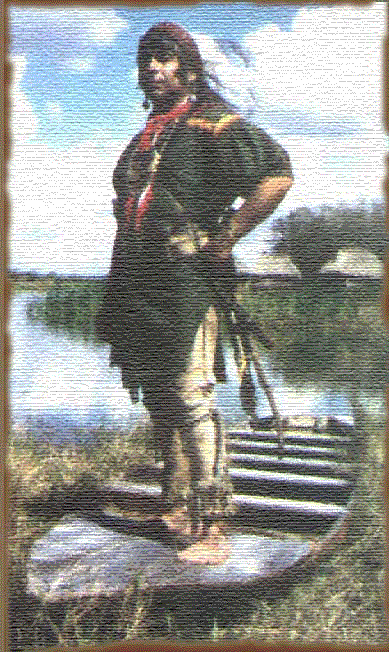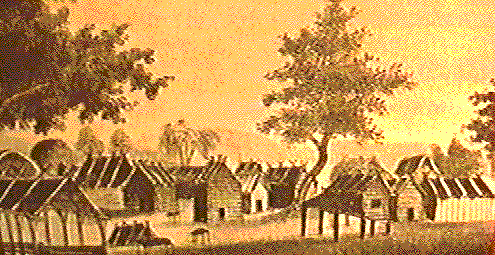
 History HistoryThe Unconquered Seminoles by Dru J. Murray The Seminoles. A fierce, proud tribe of Florida, let neither three wars with the United States Army or the harsh Everglade swamps defeat them. Related Stories:

The term "Seminole" is a derivative of "cimarron" which means "wild men" in Spanish. The original Seminoles were given this name because they were Indians who had escaped from slavery in the British-controlled northern colonies. When they came to Florida, they were not called Seminoles as they were actually Creeks, Indians of Muskogee derivation. The Muskogean tribes comprised the Mississipian culture which were temple-mound builders. Among the Muskogean tribes were the Creeks, Hitichis and Yamasees of Georgia, the Apalachees of Florida, the Alabamas and Mobiles of Alabama, and the Choctaws, Chickasaws and Houmas of Mississippi. The Origins of the Seminoles By this time, many of the tribes in Florida, including the Tequestas, Calusas, Apalachees, Timucans and others, had been decimated by the Spanish presence, either in battles or by diseases such as smallpox. Out of an estimated 100,000 native Americans that occupied Florida during the 1500s, less than 50 survived. In 1767, Upper Creeks from Alabama, who spoke the Muskogee language, settled in the Tampa area. Shortly after this, in 1771, the first recorded usage of the name "Seminole" to denote an actual tribe was recorded. In 1778, the Seminoles were joined by more Lower Creeks and a few Apalachees. The Five Civilized Tribes
Originally, the Seminoles were hunters who used muskets to hunt deer, turkey and other game and who fished. They gathered fruits, nuts and berries. Later, however, they settled down and became excellent farmers. They grew corn, sugarcane, guava and bananas. They also were successful in raising stock, including horses and cattle. The Seminole Wars
Trouble erupted again in 1817 when Americans crossed the Florida border to arrest a Seminole chief. That led to the First Seminole War which began a year later when Andrew Jackson crossed the border with troops. Jackson and his men ruthlessly burned Seminole villages and captured the Spanish towns of St. Marks and Pensacola. Unfortunately for the Seminoles, Spain ceded Florida to the United States in 1819. This gave Americans wanting to settle the lush state an opportunity. Though they got the Seminoles to agree to move onto a reservation in the state's center, their greed was insatiable. The settlers wanted more. On May 28, 1830, the settlers got the backing they wanted from the U.S. government. The Indian Removal Act was passed by Congress at President Andrew Jackson's urging. The Indian Removal Act gave the government the authority to remove all the Five Civilized Tribes east of the Mississippi to the Indian Territory in Arkansas and Oklahoma. While the bill specified that the consent of the Indians had to be obtained and compensation dispersed to the tribes, the reality of the situation was that those who did not go peacefully were forced to go anyway. The Choctaws left for Indian Territory in 1831, the Creeks in 1835 and the Chickasaws in 1837. Some were deported in manacles. The Cherokees forestalled removal by using their legal knowledge to sue the government. They argued their case well. Supreme Court Justice John Marshall agreed with the Cherokees' viewpoint. Jackson defiantly stated, "John Marshall has made his decision, now let him enforce it." So, the Cherokees too were forced off their land and onto the "Trail of Tears," a horrendous march to the Indian Territory. The "Trail of Tears" claimed thousands of lives including one-fourth of the Cherokee Tribe due to hunger, cold, disease and sorrow.
Frustrated by Osceola's continuing successes, General Jesup resorted to deception, luring Osceola and fellow Seminoles into a trap under the guise of a meeting on peace. Osceola was captured and imprisoned, where he contracted a fatal illness and died. However, 19 of his fellow prisoners, including a daring leader named Wild Cat and John Horse, a Black Seminole, escaped. These two rode many miles together in a friendship that lasted a lifetime. After their escape, Wild Cat and John Horse made their way to friends who helped them by giving them supplies. A force of 1,050 led by General Zachary Taylor pursued the escaped prisoners until they were met by hundreds of Seminoles lying in wait at Lake Okeechobee (a Seminole word which means "plenty big water") in the state's center. The withering fire delivered by the Seminoles under the leadership of Sam Jones, Alligator and Wildcat (Coachoochee) at the Battle of Okeechobee ended in resounding defeat on Christmas Day 1838, for the U.S. forces: 28 U.S. dead and 112 wounded. Only 10 Seminoles died in the battle.
Around 500 Seminoles remained in Florida, managing to hide in the Everglades, moving ever southward into areas where white men dared not venture. Though leaders such as Wild Cat, John Horse and others met with President Polk for peace talks in the nation's capital, the Seminoles' resistance did not fade.
Further Troubles The Dawes Act confused those who were used to tribal ownership and left the Indians prey to greedy whites waiting to snatch their land. At first the Five Civilized Tribes were spared having to abide by the Dawes Act, but by 1905, they too were allotted their lands under its rules.
Ironically, Indians, who had inhabited the great continent long before the white man came, became citizens of the United States via the Snyder Act during World War I. In 1934, the Wheeler-Howard Act, or Indian Reorganization Act, made life better for the Indians. It allowed Indians to compose tribal constitutions, elect tribal councils, and create tribal institutions. It also extended financial credit to the tribes, stipulated needed improvements in educational and medical facilities, restored religious freedom and encouraged the revival of Indian culture.
To combat a House resolution that would terminate assistance to Indian tribes, Seminole tribe members worked to officially organize the tribe with a constitution and charter. On August 21, 1957, a majority of the tribe voted in favor of the creation of the Seminole Tribe of Florida. Some of the tribe, those speaking the Mikosuki language, split off to form the Miccosukee Tribe of Florida. Today, the Seminole Tribe is engaged in creating economic opportunity for its members, preserving its proud heritage and culture and working to preserve its homeland, the Everglades of Florida. The Seminoles' indomitable spirit, that of the unconquered, will carry them far. < |




 War broke out again in 1855 when a military survey party was attacked by
Chief Billy Bowlegs in Collier County. The Third Seminole War lasted
until 1858. The few remaining Seminoles who lived in the Everglades
traded skins and hides at trading posts and raised cattle.
War broke out again in 1855 when a military survey party was attacked by
Chief Billy Bowlegs in Collier County. The Third Seminole War lasted
until 1858. The few remaining Seminoles who lived in the Everglades
traded skins and hides at trading posts and raised cattle.
